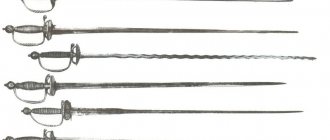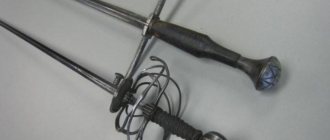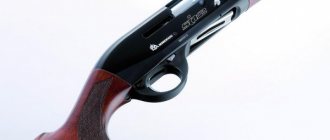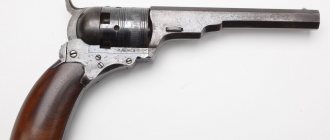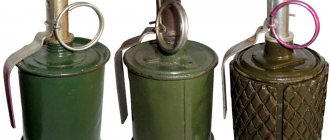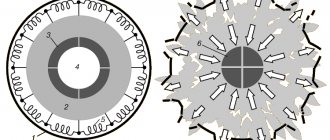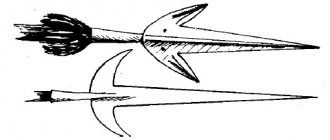Edged weapons fascinate and attract: they are both beautiful and deadly at the same time. The pleasant heaviness in the hand, the whistle of air cut by the blade - these sensations are difficult to compare with anything. Let's get acquainted with a group of representatives of these wonderful inventions of mankind.
A sword is the pride of every self-respecting warrior, it is strength and courage, it is the subject of knighting, it is beauty and admiration. And a beautiful handle greatly decorates a bladed weapon. Today I will present a selection of beautiful sword hilts and more. Mostly these will be representatives of basket swords.
A sword with a basket guard is a collective name for a group of swords that were distinguished by a characteristic guard shape. There are three main types of “basket” swords: 1. Scottish basket sword. 2.Schiavona. 3. Haudegen
The history of the sword
Obviously, the sword is a logical development of the sword. This does not mean that it is better than the sword. It’s just that every time requires its own weapon. It is clear that in Medieval times a sword would be useless against armor. But during the Renaissance, it was an effective fighting tool.
The appearance of firearms is directly related to the appearance of the sword. At that time, heavy armor was no longer required, since it was useless in front of bullets. But some historians argue that the sword was precisely intended for piercing blows between the plates of armor.
In words it looks beautiful, but in practice it is rather an impossible task. For example, Maximilian armor had the same degree of protection as a spacesuit. Hitting such an enemy with a sword was quite difficult. The early sword was not much different from the sword, but it was lighter and more elegant.
Fencing techniques led to a different grip on the weapon. Now piercing movements were important, not chopping. The index finger rested on the cross, and it needed additional protection.
By this time, plate metal gloves had gone out of fashion; they made it difficult to handle firearms. So the hilt of the sword turned into a complex structure, by which it is perfectly recognizable. According to some sources, it is believed that the place where the first sword appeared is Spain.
The product was perfect for everyday wear. The weapon quickly gained popularity among the noble class. The sword was richly decorated to emphasize the status of the owner. During this period, weapons began to be divided into civilian and military. Closer to the 16th century, the product was called “espadas roperas”.
The heyday of the sword can be called the 18th century. Civilian weapons were lighter than combat weapons and slightly shorter. Only the edge was sharpened. At the end of the 17th century, the first school of sword fencing appeared. At this time, the weapon loses its chopping characteristics. And at the same time, the sword blade becomes faceted.
Sword hilt.
The most popular were triangular products, but there were also hexagonal ones. Wearing a sword was a privilege; even students wore it. Young boys often used them in duels. And they were even proud of the scars left after the fight.
Under Peter 1, all infantry were armed with a sword. But then it was replaced with a half-saber. The sword was left to the officers and guards musketeers. In the 19th century, the sword was replaced by sabers and it gradually lost its combat significance.
Receiving an item
Methods of obtaining
This item can be obtained in the following ways:
| Qty | Ingredient | General Notes | Type |
| 9 | Jester
| random RuthlessRuthlessPrefix(170-179)% increased physical damage for level 100 one-handed weapons | Automatically |
| 9 | Tyrant
| random RuthlessRuthlessPrefix(170-179)% increased physical damage for level 100 weapons | Automatically |
| 8 | Web
| random weapon craftcraftsuffixcan have up to 3 craft properties | Automatically |
Sword device
Like any other bladed weapon, a sword consists of a hilt and a blade. The blade is straight and flat with double-sided sharpening. There are one or two lobes on it. The blade gradually tapers towards the tip.
What was the length of the blade?
The blade was 1 meter long.
What happened later?
A little later it shortened to 70-80 cm.
Sometimes there were products with a square, rhombic or oval blade. In this case, the sharpening remained only at the tip. The weight of the sword reached 1.2-1.6 kg. The musketeers' swords weighed 1.5 kg. The most difficult part of the sword is the hilt, it consisted of:
- the handle was made of metal or wood and had braiding or corrugation to securely hold the product in the hand;
- the crosshair was straight or slightly inclined;
- a protective device for fingers - a bow, was in the form of a strip of metal from the cross to the pommel;
- the pommel that completes the handle served to balance the sword; it was made in the form of a ball or cap;
- protection of the hand - a guard, was made of protective rings and attached to the crosshair. There were options in the form of shields or baskets that completely covered the hand.
Early examples of the sword were distinguished by a simple hilt. There was a simple cross with a bow. Later versions received a basket guard, on top of a developed crosshair. There were 2-3 arms, they covered the hand.
The handle was placed on the shank of the blade and fixed tightly. It could be round or rectangular in cross section. It was also covered with leather or fabric.
And on top it was covered with metal wire. Fencing school affected the look of the guard. Spanish masters preferred completely closed guards.
But the French had a developed wrist technique, and a light guard was preferred. Later, on civilian items that were considered court decorations and ceremonial weapons, the hilts began to be decorated with precious stones.
Such swords turned into a number of works of art. And the crosshair disappeared completely. The combat versions were much simpler; they had a small crosshair, a bow and two shields. The overall length of the sword depended on the craftsman who forged it.
Combat sword.
Types of hilts according to Oakeshott
According to the typology of the famous historian Ewart Oakeshott, guards were divided according to the degree of closure of the wrist. According to its type, types of swords are divided that have pronounced properties characteristic of this weapon. Let's look at them in more detail:
- The hilt is in one quarter, has a crosspiece, semicircular arms, a single lower ring or branch, and a counter-guard from one arch.
- A half hilt has a cross guard, semicircular bows in front of the cross guard, a double lower ring or branches, and a counter guard usually consisting of two bows.
- The hilt is in three quarters, the front branch of the cross is bent to form a protective bow, semicircular bows in front of the cross, a double (sometimes triple) lower ring or branches, a counter guard usually consisting of two bows (loops).
- Full hilt, has a crossguard, semicircular bows in front of the crossguard, a complex lower ring, a protective C-shaped bow, and a counter-guard of three bows.
- The Pappenheimer hilt consists of two perforated shells.
- The hilt is a loop, consisting of a bifurcating bow, forming a loop.
- A basket hilt, which is often classified as a sword. Quite a developed hilt in the shape of a cage or basket.
- The hilt is bent, differs from the previous version by thicker bent rings.
- Plate or Flemish hilt, short products originated from these types of swords.
- The hilt is cavalry, heavy, similar to the hilt of short swords, but with the obligatory protective bow.
- The hilt is a bowl, it is known as Casoleta or Bretta. The cup-shaped hilt itself was quite popular among duelists.
- Bilbo type hilt, had two shells.
There were also swords with a wavy blade, similar to the flamberge sword. This sword caused wounds that were difficult to heal. It was popular among professional bruisers. But it did not receive mass distribution.
Hilts of various types.
Schiavona
SCHIAVONA (Italian schiavona - Slavic, Slavic) is a type of straight sword of the Renaissance era with a basket guard. The very name of this type of sword is medieval jargon, which migrated first into everyday use of its time, and then into scientific terminology. It is simply translated: Slavic. Without a doubt, this is an abbreviation for the descriptive La espada schiavona - Slavic sword (in Italian the sword is feminine). It can be literally translated into Russian as Slavyanka, as in the famous portrait of Titian from 1508-10. from the British National Gallery, London “Portrait of a Lady” (La Schiavona). The hilt of these swords has a square or rectangular pommel with a rounded protrusion in the center. The crosshair is often bent horizontally, and sometimes this is done so dashingly that it resembles the number “eight”. Guards of this type can be traced in Hungarian swords of the 14th-15th centuries.
8.
9.
10.
11.
Product Features
The sword is a noble weapon; it was made of high-quality steel. It is incomparable to the soft blades of swords. The technical characteristics and types of swords attracted the close attention of the nobles. The focus of the product on injection required high quality production.
Therefore, weapons became the hallmark of the nobility. Less wealthy people preferred cheaper sabers and swords. In addition, the sword required fencing skills. Special schools were created. A commoner could not get into it.
Italian swords, designed only for piercing blows, do not use chopping blows in their fencing technique. Also quite interesting is the French school, which is also aimed at thrusting, but the sword has a lighter guard and usually has a triangular blade.
Therefore, musketeers' swords are short with an open guard.
But the Germans, on the contrary, used a full range of strikes. Slashing, piercing and cutting, and even a stunning blow with a flat blow. The Spanish school of fencing, called distreza, included a whole philosophy of blade fighting. But the strongest were the French and Italian schools.
Sports foil
Sports foils differ from swords in their parameters. So, the cross-section of the rapier is tetrahedral. The length of the blade is 90-110 cm, and the weight of the weapon does not exceed 500 g. The hand is protected by a metal guard with a diameter of 12 cm.
The blade proportionally decreases in cross-section towards the apex, which is equipped with a tip with a diameter of 6 mm.
For weapons used in competitions, the tip is a movable electrical contact device. It reacts to a thrust inflicted on the enemy. When the circuit is closed, the signal is sent through a wire that runs along the recess of the edge from the tip to the guard. Under the guard there is a connector to which a wire is glued.
In addition to the basic parameters, there is one more difference between a rapier and a sword. Sport allows you to use different tactics and combat techniques. It is the rapier that sometimes allows you to replace a straight handle with a figured one. This shape is called a “pistol” shape and allows you to avoid bending your wrist while gripping the handle.
Fencing
I wonder if fencing today is similar to sword fights of the past. They say that if you send today's athlete back into the past, he will defeat any sword master. Is this so? Let's try to find out.
Today, the most important tactical technique is the lunge thrust, which is completely absent in ancient fencing schools. But would the technique work in a real fight?
The lunge attack stretches the fighter's stance. In this position, the athlete is static, and it is difficult for him to repel other attacks.
It should be taken into account that in modern fencing, after an injection, the fight is stopped. In a real battle, no one will stop there. One injection does not guarantee victory over the enemy; he must be finished off.
In modern fencing, whoever pins first gets a point. In a real fight, a thrust is not a lost point, it is an injury or even death. It should be borne in mind that in the past, schools taught not only how to wield a blade, but also how to move correctly in battle. These are all kinds of rebounds, departures from the line of attack and changes in the level of battle.
In modern conditions, leaving the line of attack is considered unacceptable. Again, a modern sword, this is a fairly light product weighing 700-750 grams. The main task is to lightly touch the opponent with the tip of the blade. And the swords of the old masters weighed up to 1.5 kg. And in addition to injections, some swords could be used to chop.
And deprive the enemy of an entire limb. There is a myth about the strong difference between the fencing schools of Europe and the East. This is not so, eastern masters also switched to lighter weapons, abandoning swords. And there is no doubt about the virtuosity of their fighting technique.
Modern fencing.
The most famous 5 swords
Swords made it possible to defend one’s honor and dignity just as well as swords. It could be used to attack and defend. Gradually, the sword spread to almost all branches of the military. Until the 18th century, the sword was in service with both infantry and cavalry. And only a little later, the saber was able to push the sword out of the battlefield.
Sword of the Swedish king Gustav II Adolf
The brilliant commander and brave warrior was killed by several point-blank shots from a firearm. This happened in 1632, the sword was with its king, and unfortunately it could not help him.
The product itself is interesting because of its well-designed hilt, which even has a thumb ring. Although the blade itself is narrow, the width at the hilt is 2.8 cm. The total length of the product is 1156 mm, the length of the blade is 990 mm, and it weighs 1410 grams. This was not enough for slashing attacks.
Sword of King Gustav II.
Swedish Drabant sword
The sword of the guards of Charles 12 will impress anyone. And the guards themselves were selected to meet certain requirements. Their height had to be from 175 to 200 cm, and they simply had to be an excellent horseman. And they even had to be literate.
The sword itself, in a light version, was supplied to the Swedish army. Similar examples were created for the Russian cavalry under Peter I. The weight and size of the weapon inspired respect. This is a sword of the 1701 model. The total length of the product was 1155 mm, while the blade was 977 mm long. The blade width was 4 cm and the sword weighed 1410 grams.
Swedish drabant sword.
Noble camisole sword
The weapon struck not with the edge of the blade, but with its beauty and luxury. It quickly turned into a work of art. The hilts lost all the properties of combat readiness, but the decoration was at its best. There was even a fashion for porcelain handles, which made it clear that it was impossible to fight.
It was a weapon for seducing society ladies. The total length of the product was 844 mm, the length of the blade was 706 mm, the width of the blade was only 17 mm and the weight of the product was 270 grams.
Beautiful noble products.
Colishemard sword
This was an attempt to adapt the noble camisole sword with its thin blade to the conditions of harsh combat. It was a fairly light and small weapon that was easy to handle. The comfortable handle ensured excellent control of the blade. This is how the sword appeared - the kolishemard.
A weapon with the hilt of a camisole sword and a blade that was divided into two parts. There was a thick and strong part at the handle, which should have taken blows, and a thin part, which should work with surgical precision. The Swedish kolishemard of the 1790 model had a length of 1005 mm, with a blade of 845 mm. The blade width was 34 mm and it weighed 680 grams.
An interesting sword is the kolishemard.
Notes
- ↑ European Weapons and Armour. From the Renaissance to the Industrial Revolution” by Ewart Oakeshott, FSA ISBN 0-85115-789-0, section “The Reitschwert or 'Sword' and the Rapier”, pages 134-139 in the 2000 edition from Boydell Press, Woobrige
- ↑ "European Weapons and Armour. From the Renaissance to the Industrial Revolution" by Ewart Oakeshott, FSA ISBN 0-85115-789-0, Chapter XIV "The SmallSword", pages 236-253 in the 2000 edition from Boydell Press, Woobrige
- ↑ "European Weapons and Armour. From the Renaissance to the Industrial Revolution" by Ewart Oakeshott, FSA ISBN 0-85115-789-0, Chapter XIV "The SmallSword", section "Blades" pages 251-252 in the 2000 edition from Boydell Press, Woobrige
- "European Weapons and Armour. From the Renaissance to the Industrial Revolution" by Ewart Oakeshott, FSA ISBN 0-85115-789-0, Chapter XIV "The SmallSword", section "Blades" pages 251-252 in the 2000 edition from Boydell Press, Woobrige
- Wendelin Boeheim “Handbuch der Waffenkunde. Das Waffenwesen in seiner historischen Entwicklung vom Beginn des Mittelalters bis zum Ende des 18 Jahrhunders" Leipzig 1890, chapters "Degen" and "Dolch"
- Wendelin Boeheim “Handbuch der Waffenkunde. Das Waffenwesen in seiner historischen Entwicklung vom Beginn des Mittelalters bis zum Ende des 18 Jahrhunders" Leipzig 1890, chapter "Dolch"
- European Weapons and Armour. From the Renaissance to the Industrial Revolution” Ewart Oakeshott, FSA ISBN 0-85115-789-0
- ↑ "European Weapons and Armour. From the Renaissance to the Industrial Revolution" by Ewart Oakeshott, FSA ISBN 0-85115-789-0, Chapter VI "Swords of the Sixteenth Century", section "The Reitschwert or 'Sword' and the Rapier", pages 134-139 in the edition 2000 from Boydell Press, Woobrige
- "European Weapons and Armour. From the Renaissance to the Industrial Revolution" by Ewart Oakeshott, FSA ISBN 0-85115-789-0, chapters VI "Swords of the Sixteenth Century", IX "Sword and Rapier in the Seventeenth Century" and X "The Military Sword of the Seventeenth" Century"
- "European Weapons and Armour. From the Renaissance to the Industrial Revolution" by Ewart Oakeshott, FSA ISBN 0-85115-789-0, chapters VI "Swords of the Sixteenth Century", IX "Sword and Rapier in the Seventeenth Century" and XIV "The SmallSword"
- "European Weapons and Armour. From the Renaissance to the Industrial Revolution" by Ewart Oakeshott, FSA ISBN 0-85115-789-0, chapter VI "Swords of the Sixteenth Century", section "Four Families of Swords", pages 126-127, in the 2000 edition from Boydell Press, Woobrige
- "European Weapons and Armour. From the Renaissance to the Industrial Revolution" Ewart Oakeshott, FSA ISBN 0-85115-789-0
- Bakal D.S. et al.
Great Olympic Encyclopedia. - M.: Eksmo, 2008. - P. 586.
